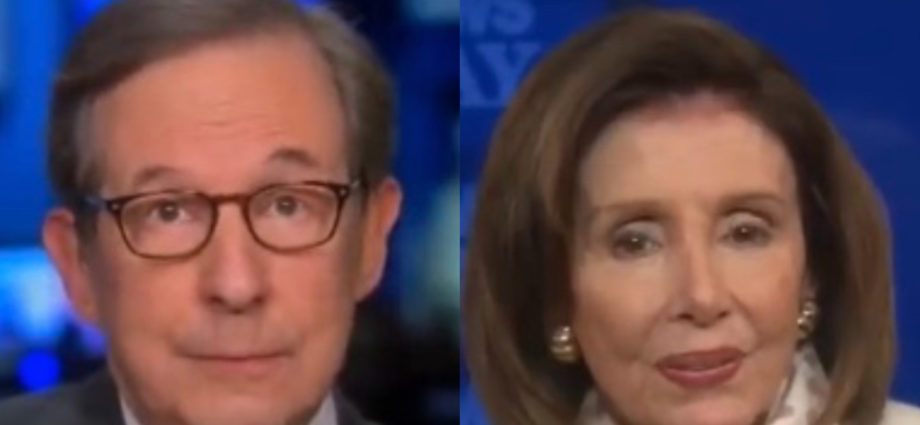House Speaker Nancy Pelosi appeared on Fox News today with Chris Wallace and he asked her if, when she visited Chinatown in February, “If the president underplayed the threat in the early days, Speaker Pelosi, didn’t you as well?”
She responded “No. What we’re trying to do is to end the discrimination, the stigma, that was going out against the Asian-American community.” She said that Chinatown has been “a model” for containing the Coronavirus.
Fox News' Chris Wallace calls out Nancy Pelosi for promoting tourism during the coronavirus pandemic pic.twitter.com/tkhte8qRYD
— Steve Guest (@SteveGuest) April 19, 2020
Wallace: As you are right now, have been very critical of President Trump, especially for the time that you say he lost initially in January and February in responding to the virus but I want to point out that on February 24th, you went on a walking tour to try to promote tourism.
An article released on February 27th confirms that was the case. It’s titled: ‘Please visit Chinatown’: coronavirus fears empty San Francisco district.
It talks about how the district was empty because nobody was visiting. “As you can see, there’s nobody,” said Ivy Liu, store manager at Bargain Bazaar, as she took inventory in an empty store. “It’s really, really, really difficult. All the people, I don’t know where all the people have gone.”
The concern was enough that Pelosi, made a publicized stop this week in her home town’s Chinatown to implore people to “please come and visit and enjoy Chinatown”.
“We know that there is concern surrounding tourism, traveling all throughout the world, but we think it’s very safe to be in Chinatown and hope that others will come,” she said. “It’s lovely here.”
On March 17th, another article said that the Stay at Home order had left the streets eerily empty. Chinatown, normally a bustling neighborhood is quiet, the streets empty, the shops closed.
An article released today praises Chinatown’s response without mentioning the fact that people weren’t visiting there at a normal pace or the stay at home orders.
On January 24th, the eve of the Chinese New Year, Dr. Jian Zhang, chief executive of San Francisco’s Chinese Hospital, saw an alarming photograph as she scrolled through her holiday greetings on WeChat. An old medical school colleague was about to join more than 100 other health care providers being rushed to Wuhan to help manage the coronavirus outbreak.
A perfect storm seemed to be headed for the 22 square blocks that make up Chinatown, one of the most densely populated neighborhoods in the United States. Chinese Hospital, which Zhang has led since 2017, is an acute care facility in the heart of Chinatown. Travel between Chinatown and China is constant.
Zhang called Aaron Peskin, a San Francisco supervisor who represents Chinatown. “If we have an outbreak in Chinatown,” she told him, “it will be a nightmare of yours and mine.” But Chinatown has thus far held off the nightmare.
Chinese Hospital admitted its first COVID-19 patient on March 26, three weeks after patients had been hospitalized in other parts of San Francisco
As of mid-April, at least 34 cases of COVID-19 had been detected in 22 SROs around San Francisco, according to figures collected by Peskin’s office. None of these cases were within those 22 square blocks, although three were on the border of Chinatown.
On February 1st, one week after Chinese New Year, Zhang, Peskin and Chinatown community leaders hosted a news conference highlighting practices to slow the spread of the virus. The Chinese Consul General in San Francisco gave an update on the Chinese government’s response.
In early February, the principal of Central Chinese High School announced an initiative to sterilize classrooms and encouraged teachers and students recently in China to stay home for a 14-day self-quarantine.
By mid-February, the Chinatown Community Development Center, the owner of 11 SROs housing several hundred tenants, had installed hand sanitizers in their buildings, doubled up on daily cleanings and started educating tenants about basic hygiene principles.
Peskin saw the effects of this informal campaign every day when he drove through Chinatown on his way to City Hall. “For a while it was kind of startling that on one side, on the north side of Broadway, everything was ‘normal’ and nobody was wearing masks,” he said. “And the second you would cross Broadway into Chinatown, everybody was wearing masks.”
On the streets of Chinatown, about 80% of the restaurants are shuttered. Produce markets, fish sellers and butchers are gamely trying to stay solvent with socially distanced shopping in what are often confined spaces.
- Tim Kaine Provides Cover For Joe Biden on the Border Crisis, Blames Lack of a ‘Robust Work Visa Program’ for ‘Some of the Chaos at the Border’ - March 27, 2024
- Elon Musk Rips NBC For Hiring and ‘Immediately’ Firing Ronna McDaniel ‘That’s How Biased They Are!’ - March 27, 2024
- Marjorie Taylor Greene Makes Move, Files Motion to Vacate Against Speaker Mike Johnson After House Passage of $1.2T Spending Bill - March 22, 2024

